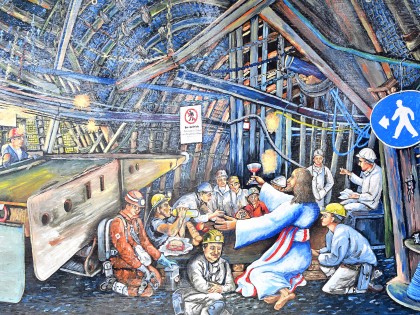The cover of Prof. Fr Thomas O’Loughlin’s new book Eating Together, Becoming One (reviewed in our issue of April 2) carries an image that very powerfully evoked themes that the author has explored as an historian and theologian.
As a cover image it lost some of its impact as a work of art. In this essay, illustrated by a larger version of the painting, Prof. O’Loughlin explains the provenance of the image, its meaning as a piece of art, and its theological significance.
This painting entitled Das Abendmahl unter Tage – ‘The Eucharist Underground’ – is a piece of public art on an underpass in the town of Westerholt in North Rhein-Westphalia, Germany.
It was painted in 2011 by Helmut Dellmann, who died April 18, 2013, and who was a founding member of the local miners’ old-comrades’ association that now cares for the painting.
But when we look at it for the first time it seems to shock us!
Solemnity
This is not the Eucharist as a great solemn liturgical action – wondrous vestments, solemnity, clouds of incense producing a ‘other worldly’ feel, all to the ethereal sound-track of chant in Latin!
Likewise, it is not a scene reminiscent of Leonardo’s Last Supper – nor any of the other images of the Last Supper that we know centuries of western art devoted to the theme.
What we see are cables, pneumatic drills, wagons, and men in hard hats. Surely this is not a sacred scene – this is a workplace. It is even less than ordinary because this is not nice work, this is the hard toil of those who earn their bread with their hands and the sweat of their brows in a place where danger is ever present.
Now look more closely. There in the middle of the world of work, our everyday world, is present the Word who has come and pitched his tent in the middle of our lives (John 1:4). Jesus is there offering to share his meal with those who are sharing their meal.
This is their – the miners with Jesus – common offering to the Father. All are one and are smiling – and on the right-hand side of the picture is a street sign bidding every human being to enter this sacred space. There is no special priest figure in the picture: the whole group are part of the priestly people by baptism.
Now look yet again. It is our everyday ordinary world, but it is also extraordinary. It is a scene of joy and smiles. It a world of work, but also of sharing and rejoicing. It is a world in the presence of the Christ.
This is very much a Christ-ian sacred space.
This mural presents the eucharist not only as an activity of the people of God in union with Jesus, but as an incarnational event.
Through, and with Jesus, the Anointed One, we present our praise and thanksgiving for all we are and have to God”
Rather than occurring in a sacred space apart from the world, it enters into the workspace and transforms that location into a place of divine encounter and an experience of community rejoicing.
Eucharist is an activity of Jesus and his followers – directed to our Father in heaven – it is not a commodity that we have provided for us, that we ‘get’, or that is ministered to us.
We do it when we gather, when we break and share the loaf, share the cup, and in, through, and with Jesus, the Anointed One, we present our praise and thanksgiving for all we are and have to God.
But could Jesus be in that mine? ‘Where two or three are gathered in my name, there am I in the midst of them’ (Matt 18:20). You cannot get it clearer than that!
Dublin-born Thomas O’Loughlin is Professor of Historical Theology at the University of Nottingham.


 Peter Costello
Peter Costello Das Abendmahl unter Tage – ‘The Eucharist Underground’ by Helmut Dellmann
Das Abendmahl unter Tage – ‘The Eucharist Underground’ by Helmut Dellmann 